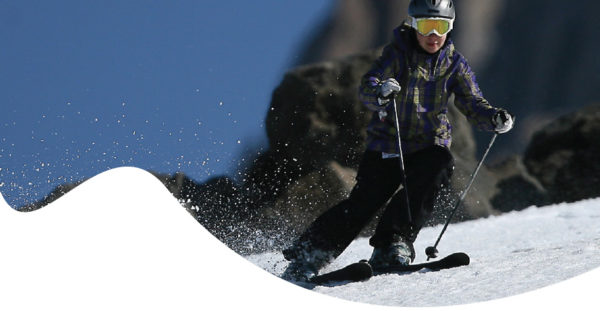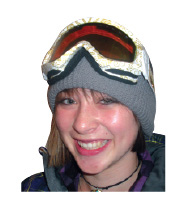It’s not the Tool, but How You Use It
by Marissa Nishimoto, photo by Matt Aimonetti
 Sliding is fun! That’s why we do what we do right? Whether it’s alpine, telemark, snowboard, or Nordic, we are in the snowsports industry, one industry, to help others enjoy snow sports as much as we do. And perhaps, at the same time, for selfish reasons, to improve our own skills, which in turn will better serve our customers. That understood, the question begs to be answered: why should it matter whether we slide on two pieces of equipment or one? Why is it that some skiers and snowboarders seem to think that they are two different species? This is an age-old rivalry has been played out and determined officially dead by the end of the 1998 Winter Olympics. It’s our role as educators to dispel this animosity between skiers and snowboarders, and focus on teaching and modeling the attitudes and behavior of coexistence.
Sliding is fun! That’s why we do what we do right? Whether it’s alpine, telemark, snowboard, or Nordic, we are in the snowsports industry, one industry, to help others enjoy snow sports as much as we do. And perhaps, at the same time, for selfish reasons, to improve our own skills, which in turn will better serve our customers. That understood, the question begs to be answered: why should it matter whether we slide on two pieces of equipment or one? Why is it that some skiers and snowboarders seem to think that they are two different species? This is an age-old rivalry has been played out and determined officially dead by the end of the 1998 Winter Olympics. It’s our role as educators to dispel this animosity between skiers and snowboarders, and focus on teaching and modeling the attitudes and behavior of coexistence.
As snowsports educators our job is to teach and inspire our students. We also share our enthusiasm and passion for whatever we are teaching. We slide, we glide, some carve, some float, others fly, but the medium is the same: snow. On the tool of our choice, no matter what that is, we are just people – not “snowboarders” or “skiers” – just people enjoying the mountain together. However, that seems to get lost in the shuffle at times, when people get caught up in the “scene” of whatever that may be. I know this first-hand, because as a multi-discipline snowsports instructor, I’ve experienced it many times. Among various ski schools or ski areas, where “snowboarders” and “free skiers”, typically known as the younger crowd, are treated as second class citizens. Yep, I’m sensitive to this because I snowboard, and ski, and I am 17 years old. We all need to remember that there is a person behind all that gear, complete with their own background, attributes and values that are not fully known by looking at their gear or their face. Sure, how a person carries themselves says a lot, but please don’t “judge a book by its cover.”
Depending on what I am carrying, sometimes you “see” a snowboarder, and other times they “see” a skier, but it’s always the same person inside.
When people look at me they “see” a girl, admittedly rather short, who looks obviously quite young. Depending on what I am carrying, sometimes they “see” a snowboarder, and other times they “see” a skier, but it’s always the same person inside. On one particular weekend last July, I was a “skier” attending a 3-day clinic on Mt. Hood. During a casual conversation one of my fellow clinic participants suggested that snowboarders need their own mountain because they are a “danger.” OK, well at this point, I look like a “skier” but the “snowboarder” part of me was a little offended. This is not an issue of snowboarding or skiing or telemarking or those even radical Nordic trail users. Granted, at Timberline in the summer, where all different user groups are concentrated in one area, tensions mount, but this is when tolerance and “good behavior” matters the most.
Resorts across the nation have addressed user conflict by providing designated areas for certain activities like Nordic skiing trails, terrain parks and slow areas for beginners or families. This helps define user activities and mitigate user conflict. This is not a discipline conflict. Don’t confuse the two.
Let’s contemplate skiing vs. snowboarding technique for a moment. Is the technique so vastly different? Negative. Many fundamental movements are very similar and cross training in another discipline can help your primary one. Could it be that our overall goals are completely different? Negative again. We tend to have similar goals: to get down the mountain, get the most from our equipment and have fun doing it. When snowboarding – I want to be relaxed and confident, but not look like I’m being lazy. When skiing I might choose to say I want to look “effortless” or “efficient.” So what’s better? Given that we are all different with our own personal styles, there are various styles within snowsports. I cannot throw a double back flip, but I can carve on my board like a champ. Is one really more respectable than the other? I guess it depends on what you like.
It is ridiculous to me that a fellow snow pro would consider a specific discipline a danger. It’s not the discipline that is the danger, it’s the person’s behavior that can be questionable. This brings us squarely back to our job as snowsports educators; to teach safety, technique and “the rules” of the hill. We also should continually improve our skills in our primary discipline, and try out those “rocker skis” or venture into the trees or half-pipe to learn what the mountain experience is like for other users. It’s even a good idea to try an alternative tool to experience the sensations of being a beginner again! But whatever you slide on, a good “attitude is everything.”
Sometimes I wish we all had some signs hanging around our necks that said something like “Hello my name is (blank). I do (blank) in my spare time. My favorite sport is (blank) .” Then we might begin to realize that the person in your lesson, next to you on the chair or in the same clinic is more than just a “skier” or a “snowboarder.”
The bottom line: we, as snow pros, must teach all our classes, not only good technique but also about the Responsibility Code, and some of the subtle nuances of other disciplines, so new and seasoned mountain users can know what to expect when sliding down the hill.

Just remember, being on skis or a snowboard does not make a person more or less reckless. And above all, the Smart Style quote “Respect gets respect,” is always true no matter what you choose to slide on.
****
Marissa Nishimoto is a Level III Snowboard and Level I Alpine instructor at Stevens Pass Ski and Snowboard School at Stevens Pass, Washington. She is also a senior at Holy Names Academy in Seattle at the time this was published.
